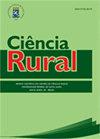猪屠宰前对初始pH值和温度的影响:一个案例研究
IF 0.9
4区 农林科学
Q3 AGRONOMY
引用次数: 0
摘要
摘要:本研究评估了米纳斯吉拉斯州一家商业屠宰场宰前处理生猪的相关因素,并评估了这些因素对胴体初始pH值和温度的影响。总共评估了4449具尸体。评价因素为运输距离、运输时间、装载密度、禁食时间、静息时间、动物平均体重、静息区平均温度、静息区最高温度。测量了这些因素对初始(即屠宰后45分钟)温度和pH值(pH45)的影响。pH45值用于判断PSE的发生;pH45 < 5.90时归为PSE。结果显示,禁食超过24小时的动物更有可能导致PSE肉(1.41倍的可能性),暴露在平均温度超过24°C的动物(1.52倍的可能性)也是如此。除动物的平均体重不影响初始温度值外,屠宰前其他因素均对pH45和初始温度值有影响,而禁食时间和休息区域温度的差异增加了PSE肉的发病率。本文章由计算机程序翻译,如有差异,请以英文原文为准。
Pre slaughter factors in pigs on initial pH and temperature: a case study
ABSTRACT: This study evaluated factors associated with the pre-slaughter handling of pigs in a commercial slaughterhouse located in Minas Gerais and evaluated the influence of these factors on the initial pH and temperature of the carcasses. In all, 4449 carcasses were evaluated. The factors evaluated were transport distance, transport duration, loading density, fasting duration, resting duration, average weight of the animals, average temperature in the resting area, and maximum temperature in the resting area. The effects of these factors on the initial (i.e., at 45 minutes after slaughter) temperature and pH (pH45) were measured. The pH45 values were used to determine the occurrence of PSE; the carcasses were classified as PSE when they presented a pH45 < 5.90. Results showed that animals fasted for more than 24 hours were more likely to result in PSE meat (1.41 times more likely), as did animals that were exposed to an average temperature above 24 °C (1.52 times more likely). Except for the average weight of the animals, which did not affect the initial temperature values, all other pre-slaughter factors have influenced both pH45 and the initial temperature values, and the difference of fasting duration and the temperature in the resting area increase the incidence of PSE meat.
求助全文
通过发布文献求助,成功后即可免费获取论文全文。
去求助
来源期刊

Ciencia Rural
AGRONOMY-
CiteScore
1.70
自引率
0.00%
发文量
233
审稿时长
2-4 weeks
期刊介绍:
The purpose of Ciência Rural is to publish the results of original research, note and reviews which contribute significantly to knowledge in Agricultural Sciences. Preference will be given to original articles that develop news concepts or experimental approaches and are not merely repositories of scientific data. The decison of acceptance for publication lies with the Editors and is based on the recommendations of Editorial Comission, Area Committee and/ or ad hoc reviewers. The editors and reviewers are external to the institution.
 求助内容:
求助内容: 应助结果提醒方式:
应助结果提醒方式:


